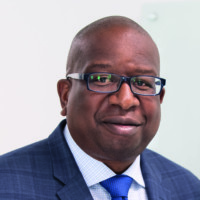
Speaking at Diversity and Inclusivity Finance Forum (DIFF) on 14 January, the lender’s group managing director of retail finance said using the phrase was not helpful as the efforts of those who dominated the sector were needed to make the profession more inclusive.
Thompson (pictured) said: “I don’t buy into the stale, pale, white male – it can cause a lot of difficulty when we speak to them like that.
“They are going to have to transform in a world where opportunity in the previous 40 or 50 years was given to them. They are going to have to be in a world where there is competition now because of diversity and inclusion.
“These are the people willing to go on that journey with us in a world that says, ‘competition isn’t a bad thing’.”
It was also the belief of peers in the industry that led to the opportunities given to Thompson which allowed him to progress as far as he had, he said.
Speaking about his role at Aldermore, Thompson added: “I’m not sure I would have got there if that job had been advertised through a headhunter. Because I’ve never had that traction with headhunters in terms of my career and putting me forward for roles.
“But Phillip [Monks] quickly recognised what I was able to do... and therefore, drove me and gave me opportunities.”
“My view is that any organisation that I work in and I leave, people should automatically think ‘if I see a person of colour, I should think that person can make a significant contribution to my business and therefore I would give that person an opportunity’,” he added.
Six step process
Thompson said he had seen more efforts to improve diversity and inclusion in the last six months than he had seen in the 29 and a half years he had been in the UK, sparked by the death of George Floyd last year.
He also made recommendations for a six step process which could help improve diversity in organisations.
This included recognising the problem of diversity and inclusion, addressing the problem and thinking of solutions, implementation, monitoring agreed targets, reviewing progress and depoliticising diversity efforts to make them business led.
Additionally, Thompson said he made sure to connect with diverse staff along the whole chain of Aldermore as he felt he had a responsibility to remain accessible to those who saw him as an inspiration and trailblazer.
“People like myself, we’ve all got a responsibility to reflect and support what they are going to do,” he added.
Thompson said: “I create time in my diary now as a senior leader so I can do induction calls with people in the organisation at all levels. It’s okay seeing me at the top of the organisation but speaking to me, they have the access to ask me questions.
“Being in that position where you can be successful in your role but still find time to reach down your organisation at that level is really significant.”
Seeking contrarian ideas
Jasjyot Singh, managing director of consumer and business banking at Lloyds Banking Group also spoke at the event.
He said for him, diversity was not necessarily about hiring people who looked a certain way but hiring people who had different ways of thinking.
“I’m keen to get people who’ve got counter perspectives to the norm. Part of my interview process is to always look for someone who’s got a contrarian perspective,” Singh said.
“What I find across teams is the gap in diversity comes not because people’s background but because of a consistency of thinking.
“If you value, encourage and look for people with contrarian perspectives, you’ll almost certainly end up with a diverse team, irrespective of what that diversity looks like.”
He added that having a diverse way of thinking also included how willing someone was to put themselves in the shoes of others when making decisions and therefore, creating suitable financial products.
Singh said: “It doesn’t matter if my experiences in the past look like something else, what matters is do I invest time and effort in thinking about what customers want and how they really feel.”
Although seeking different ideas was a priority, Singh added that public diversity goals helped to focus organisations and hold them accountable, while encouraging different people to apply for roles in the knowledge the company was actively making an effort to be inclusive.
However, he said the process was not always smooth and welcomed by all.
Singh said: “You get a few reactions. People saying ‘that’s great it feels like the right thing to do’. Others get super energised that they work for an organisation that is clear about targets and being public about it.
“On the flip side you get people who say ‘hang on a minute, what does that mean for me? There are fewer roles for people like me’.
“Over time, people like the fact that they work for an organisation that is inclusive.”















